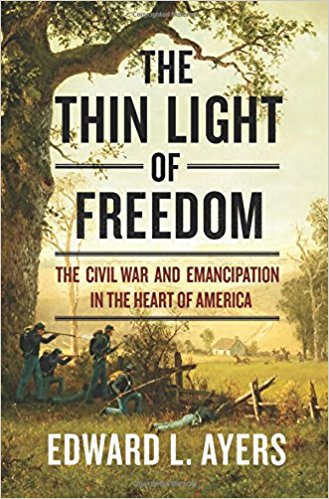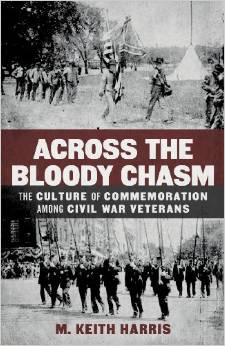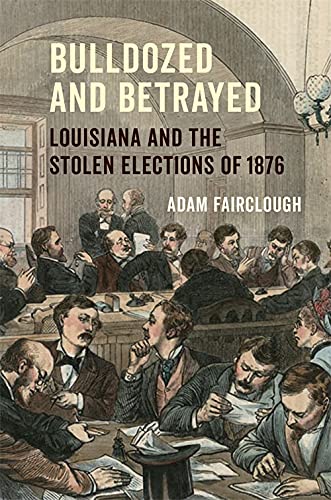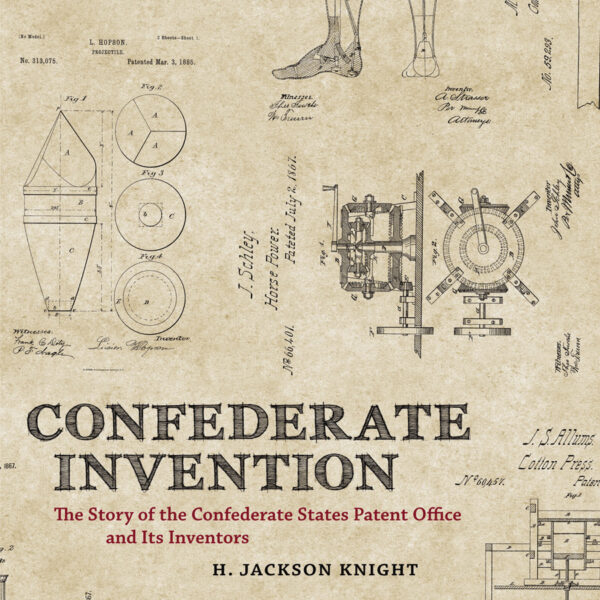The Thin Light of Freedom: The Civil War and Emancipation in the Heart of America by Edward Ayers. W.W. Norton, 2017. Cloth, ISBN: 978-0393292633. $35.00.
 At first glance, The Thin Light of Freedom appears a simple tale of two counties: Augusta, Virginia, and Franklin, Pennsylvania, both situated in the Great Valley and separated by roughly one hundred fifty miles, but also by the Mason-Dixon Line. During the final two years of combat, Union and Confederate armies battled for this strip of land so critical to the Eastern Theater, ultimately transforming the once prosperous landscape into a wasteland and turning former business partners into bitter enemies. In the end, of course, this thick if highly readable book—the recipient of the 2018 Gilder-Lehrman Lincoln Prize—is so much more.
At first glance, The Thin Light of Freedom appears a simple tale of two counties: Augusta, Virginia, and Franklin, Pennsylvania, both situated in the Great Valley and separated by roughly one hundred fifty miles, but also by the Mason-Dixon Line. During the final two years of combat, Union and Confederate armies battled for this strip of land so critical to the Eastern Theater, ultimately transforming the once prosperous landscape into a wasteland and turning former business partners into bitter enemies. In the end, of course, this thick if highly readable book—the recipient of the 2018 Gilder-Lehrman Lincoln Prize—is so much more.
Historian Edward Ayers, the former president of the University of Richmond, conceived of this volume as a sequel to his Bancroft Prize-winning In the Presence of Mine Enemies (2003), which spanned the years 1859 through early 1863. As Thin Light opens, the United States Army had been defeated at Chancellorsville, but not before emptying barns, burning fences as firewood, and liberating enslaved Virginians. At the very least, if Confederate General Robert E. Lee could use the Valley to shield his army as he marched into Pennsylvania, he could replenish his stores of food, all while making northerners understand what it felt like to be subject to an army of occupation. The Gettysburg campaign has rarely been shy of chroniclers—most recently in Allen Guelzo’s insightful Gettysburg: The Last Invasion (2013)—but what makes this particular account unique is that Ayers devotes as many pages to the thoughts of common soldiers and worried civilians as he does to Lee or General George Meade. “I just wish you could see all the crops here, Pa,” Private James Williams marveled of southern Pennsylvania. “I never saw such wheat & corn in my life” (43). Ayers has a terrific eye for illuminating detail, such as when he here observes that some of the more provincial Virginia soldiers were surprised to discover that not all Pennsylvanians spoke German.
Ayers neither patronizes nor romanticizes the men and women who people this volume, usually letting them speak for themselves without editorial comment. Free blacks and runaway slaves had settled in Franklin County, and although many African Americans relocated farther north in the years after the draconian 1850 Fugitive Slave Act, enough remained to be endangered by the professional slave traders who traveled with the Army of Northern Virginia. Local newspapers estimated that as many as fifty blacks were seized and sold south into slavery. Near Greencastle, outraged whites tried to help their black neighbors, but “some of the men were bound with ropes,” one Pennsylvanian reported, “and the children were mounted in front or behind the rebels on their horses” (46).
Hindsight, Ayers understands, is often the enemy of understanding. If historians are now inclined to regard Lee’s failed July invasion, together with the fall of Vicksburg, as the beginning of the end for the Confederacy, Ayers demonstrates that white southerners continued to place their hopes in northern war weariness and the possibility that Abraham Lincoln might not be reelected in 1864. Certainly, the endless struggles in the Valley grew ever more brutal as 1864 dragged on. Although a native of Massachusetts, Nancy Emerson had resided in Augusta for a number of years before the war. When northern cavalrymen arrived at her farm, they not only poured her flour into pillow cases, they spilled out her trunks and threw her clothing onto the floor while pretending to search for weapons. In response, Augusta’s civilian population tried to hide or bury their food and valuables, but on occasion, one complained, “some were betrayed by their [black] servants” (172). “By the summer of 1864 daily life in the war had boiled down to retribution, the chain of grievances stretching back into the past,” Ayers laments. “Excuses for many dubious actions proved all too easy to find” (174).
Although increasingly ambivalent about an endless conflict that left families hungry and wives widows, young men from both counties enlisted in significant numbers. Roughly 69 percent of Augusta’s military-aged men joined up, with a smaller ratio of 44 percent of the young white men in Franklin County signing on to the Union Army. These numbers, however, were misleading as they pertained only to white soldiers. As Governor Andrew Curtin, although a Republican, proved tardy in allowing for the recruitment of black troops, African Americans who wished to serve boarded the train for Readville, Massachusetts, and joined the pioneering Fifty-fourth Infantry. Forty-five men living in Franklin did so, and thirteen more served with its sister regiment, the Fifty-fifth. At almost the same moment that black civilians back home were trying to elude Lee’s soldiers, the Fifty-fourth attacked Battery Wagner, just south of Charleston harbor. Private William Christy survived the assault, but only because the ball he took to his chest struck his breast plate. It was through “gods will that the ball struck the plate,” Christy assured his sister, adding that if he “live to git home” he would bring it as a memento (93). The men of the Fifty-fourth, however, were never part of the United States Colored Troops, as Ayers suggests, as they chose to retain their original state designation as pride of place for being the first northern black regiment (134).
Ayers’s ground-eye view of the conflict does not end with Lee’s surrender. The lengthy second part of the volume wades into the complicated story of Reconstruction and even stretches into the present. Although defeated, few southern whites were willing to forgive. A March 1865 public meeting at the court house in Augusta condemned Lincoln as a “despotic ruler” who demanded “the abject surrender of our liberty” (320). Yet in a curious afterward, the meeting concluded with a resolution endorsing Jefferson Davis’s last-moment plans to liberate and arm a small number of bondmen. But the war ended, and instead of donating black slaves to the cause, the Valley’s northern residents instead witnessed the triumphant return of William and David Christy, who never wished their neighbors to forget that they “fought hard a many A time for them” (335). Today, Ayers notes in a brief but elegant epilogue, the Christy brothers and their sister lie in the Zion Union Cemetery in Mercersburg. Staunton features two cemeteries on either end of the town, one for fallen Confederates and one for dead Union soldiers. “The shadows of war and the thin light of freedom still fall across the Valley,” Ayers concludes (498).
Douglas R. Egerton teaches history at Le Moyne College and is the author, most recently, of Thunder At the Gates: The Black Civil War Regiments That Redeemed America, the co-winner of the 2017 Gilder-Lehrman Lincoln Prize.




